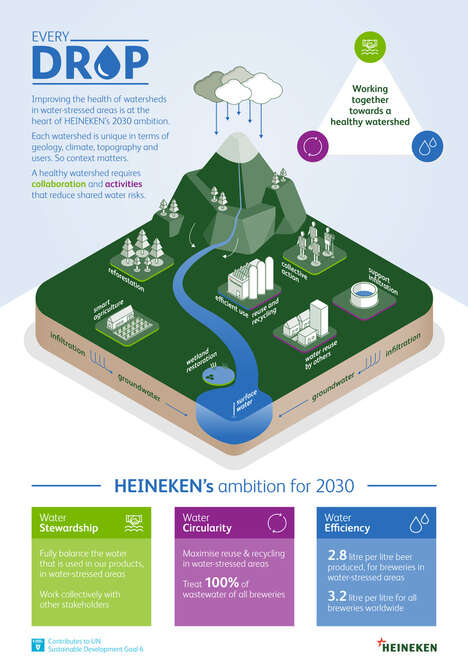Evolving Sustainable Practices
Blanca Juti Spoke with Us to Explain HEINEKEN's 2030 Water Vision
Related Trend Reports
Art & Design, Branding, Business, Drinking, Fashion, Hip Fashion, Lifestyle, Marketing, Sports Dutch brewing company HEINEKEN is one of the largest in the world, supplying its beer to more than 170 countries. As an industry leader, the company has a lot of influence, and the steps it's taken to decrease water usage has set the stage for others to follow suit.
Dutch brewing company HEINEKEN is one of the largest in the world, supplying its beer to more than 170 countries. As an industry leader, the company has a lot of influence, and the steps it's taken to decrease water usage has set the stage for others to follow suit. Recently, HEINEKEN announced its 2030 water vision in support of the United Nations Sustainable Development Goal 6. We took the opportunity to chat with Chief Corporate Affairs Officer Blanca Juti to find out more about HEINEKEN’s goals, how it plans to achieve them, and how it will impact the environment.
What steps has HEINEKEN taken to lower its water usage over the years?
In the last 10 years, we have reduced our water usage by 30% and we already treat 96% of all our wastewater so it can be returned safely to the environment. However, as more areas of the world become water stressed, we realize that focusing on efficiency and wastewater treatment is not enough. Replenishing water in areas that are water scarce is as important.
We want to put the health of a watershed at the core. Water is a shared resource and water risks are shared risks; only by collective action can the water stress in a watershed be mitigated. With our Water Balancing efforts we want to set an example, demonstrate that we are a credible partner and try to convince other users to follow in our steps.
Can you tell us a little about the water triangle that HEINEKEN has developed to preserve resources in stressed areas?
We have just introduced our water strategy and related targets for 2030: ‘Every Drop’. A healthy watershed requires that we look at water holistically, taking three key elements into account in a balanced way: water stewardship, water circularity and water efficiency. We look at these three elements as the different points of our HEINEKEN Water Triangle.
Using the water triangle, we are developing a local plan for each brewery in a water stressed area, which looks at the three critical dimensions of a watershed’s health and prioritizes the actions that are most relevant for the local one.
Under our ‘Every Drop’ water ambition for 2030, we have committed to utilize every liter of water used in our products in water stressed areas, maximize water circularity in water stressed areas, and reduce water usage to 2.8 hectoliters on average worldwide.
Heineken has already collaborated on an international basis to preserve water and drive reforestation in areas of Mexico, Spain and Indonesia—does the company have any other initiatives planned?
Today HEINEKEN is already undertaking water-balancing programs in several water stressed areas across the world. In Malaysia, we are investing in rainwater harvesting projects that will help communities save water.
In Indonesia, our employees work with local communities to install ‘biopori’ holes: narrow, meter-deep pits dug into the soil and filled with vegetable scraps and compost material. By slowing rainwater runoff, biopori holes preserve water and prevent flooding.
Another method to replenish water is desalination. In breweries near the sea, seawater can be converted to freshwater, which benefits the watershed. This is something we currently do in the Bahamas. As this process is energy intensive, in the future the use of renewable energy will help us do this with a lower carbon footprint.
The company is said to be reducing its water footprint when it comes to agriculture as well, how will HEINEKEN help local farmers to improve their practices so that they can be more environmentally friendly?
Agriculture consumes a significant part of the world's water. Barley, which is our main crop, is fortunately rain-fed and less water intensive than other crops.
Our aim is to develop agricultural practices that allow us to grow more barley with less water. In several markets, like in Mexico, we are piloting precision farming practices. In Egypt, we have a collaboration with the University of Ghent to develop early malting barley varieties that are more heat, drought and disease resistant.
As we build up knowledge and experience in this field we can scale this knowledge to other regions of the world.
References: theheinekencompany
Featured Articles

Touring Lagunitas Brewery
Lagunitas Makes Beer That Tells a Story

Cider Flavor Renaissances
Heineken Cider Innovation Center Creates New Recipes for Diverse Markets

Millennial-Inspired Media Re-Brands
Heineken Releases Its New Millennial-Inspired Brand Strategy

Co-Branded Beer Streetwear
Heineken and Union Created the #Heineken100 'Green Collar' Capsule

Branding Global Employee Narratives
Ben Clark Details Heineken's Go Places 2.0 Campaign

Collaborative Sportswear Capsules
Heineken and Kappa Created a Six-Piece #Heineken100 Capsule

Giant Champagne Bottle Beers
Sainsbury Will Sell the UK's First Magnum of Heineken This Winter

Tennis-Inspired Crossover Events
Heineken and DOE Worked Together to Drop the Masters Collection

Low-Calorie Cider Packs
The Strongbow 100 Cal Variety Pack Contains Three Different Flavors